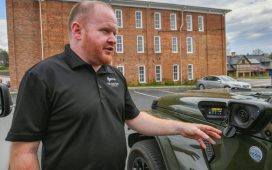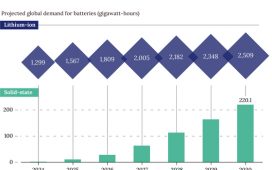The report found that while the percentage of households without an automobile has fallen steadily since 1960, it has remained relatively flat in the past decade. Income is a significant factor when it comes to car ownership, but where a person lives — whether urban or rural — also can play a role.
The report’s authors want policymakers to consider whether transportation infrastructure funding is being invested in a balanced way that meets the needs of all travelers. Individuals who opt to go without a car vs. those who can’t afford a vehicle might require different types of infrastructure investments, the report says.
Douglas S. Halpert, a civil engineer who focuses on traffic, transportation and highway design as a project manager with Greenman-Pedersen Inc., is vice chairman of ITE’s sustainability committee and recently spoke with The Washington Post about the task force’s findings. This interview has been lightly edited.
Q: How did you became interested in this topic?
A: In the transportation space, I’ve been getting more and more interested and trying to learn about implementing sustainability action items. The industry has evolved over time to include multiple modes of transportation and focusing away from just a vehicle-centric model. And now with sustainability overlapping with equity and asset management … there are just many different ways to go about tackling these different types of problems. So it’s been very educational and a lot of fun to be involved in this kind of space.
Q: What sources did you use in your research?
A: We started looking at it through census data and through the National Housing Survey. We [looked at] where people live, their income, urban versus rural, household size, age of residents. The challenge really comes when you try to layer many of these factors on top of each other.
Q: So many areas in the U.S. are designed around cars. Do you think that’s changing?
A: Urban centers are seemingly more quick to adapt to buses and bikes, sharing the roads with vehicles. Cities like Boston and New York have made strides, while Portland, Oregon, is a shining star when it comes to that. When you get out into the suburbs or the real rural areas, it’s a different story. Cars are ingrained in our culture. You see car ads on TV, but you don’t see bike ads.
Q: Were there any surprises in the data?
A: No. There were differences between urban and rural. The issues of race and income were all too familiar. I think we’d be interested in finding whether the projects [that offer alternatives to driving] are going to the places that need them.
Q: What do those demographics tell us about the people who don’t own cars?
A: There are people who are car-free and those who are carless. The car-free are the people who are choosing not to have a vehicle because they have access to other means of transportation or they work from home. The carless are people who either can’t afford or don’t have access to a car for other reasons.
Q: How could having fewer vehicles on the road change how communities are designed and engineered?
A: Having fewer vehicles on the road changes everything. You’re already seeing changes in roadway design to accommodate additional modes other than personal vehicles, and there are more analysis metrics for operations other than delay and safety, which are becoming more generally accepted. Most of these practices fall under the “complete-streets” design.
Q: What are the next steps the task force will be taking in exploring this issue?
A: We are teaming with students from Penn State Harrisburg to look at census and home survey data to overlay that with [Geographic Information Systems] data. We have test locations, which are going to vary between a small town, a midrange city and a more densely populated city to see if we can create a tool that people can use to zero in on high-priority projects to better inform their decision-making process.
Q: Do you think we’ll see more households go car-free by choice?
A: I’d like to think so. The automotive industry is certainly doing a very good job of marketing their electric vehicles, which have their benefits, but it’s still swapping out one vehicle for another vehicle. So as far as roadway congestion, there isn’t really a change there. But as folks become more aware about options they may have and as connectivity improves, perhaps people will change. And when opportunities such as [Metro’s] Silver Line become available, maybe people will make the swap or will be incentivized to make the swap. Convenience is a very powerful motivator. If it’s still more convenient for you to drive somewhere to do weekly shopping than it is to bike, then you probably still do that.
Q: Is there anything you would like to add that I didn’t ask about?
A: We are certainly not the first people to be looking at this topic. The influence of vehicles on our roadways has been long researched and heatedly debated, so we’re certainly standing on the backs of the people who came before us. We’re excited that we found a partner who can help us with the mapping questions that we have and look forward to where it goes from here.








